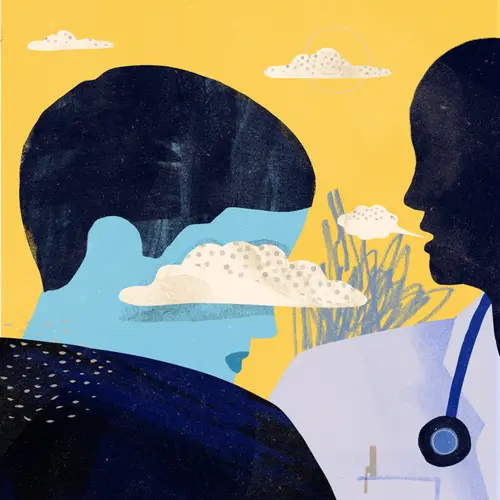Why is back pain or a knee injury annoying to one person and sheer agony to another? Turns out, an individual's tolerance to pain is as unique as the person, and is shaped by some surprising biological factors, as well as some psychological factors that we can actually try to control.
Feeling Pain
There are two steps to feeling pain. First is the biological step, for example, the pricking of skin or a headache coming on. These sensations signal the brain that the body is experiencing trouble. The second step is the brain's perception of the pain -- do we shrug off these sensations and continue our activities or do we stop everything and focus on what hurts?
"Pain is both a biochemical and neurological transmission of an unpleasant sensation and an emotional experience," Doris Cope, MD, an anesthesiologist who leads the Pain Medicine Program at the University of Pittsburgh Medical Center, tells WebMD. "Chronic pain actually changes the way the spinal cord, nerves, and brain process unpleasant stimuli causing hypersensitization, but the brain and emotions can moderate or intensify the pain." Past experiences and trauma, Cope says, influence a person's sensitivity to pain.
Managing pain and people's perceptions to their symptoms is a big challenge in a country where more than 76 million people report having pain lasting more than 24 hours, according to the American Pain Foundation. Persistent pain was reported by:
- 30% of adults aged 45 to 64
- 25% of adults aged 20 to 44
- 21% of adults aged 65 and older
More women than men report pain (27.1% compared with 24.4%), although whether women actually tolerate pain better than men remains up for scientific debate.
Pain Rising
Pain produces a significant emotional, physical, and economical toll in the U.S.Chronic pain results in health care expenses and lost income and lost productivity estimated to cost $100 billion every year.
Pain may be on the rise in the U.S. because age and excessive weight contribute to pain and discomfort. Americans are living longer into old age, and two-thirds of the population is either overweight or obese.
The most common type of chronic pain in the U.S. is back pain; the most common acute pain being musculoskeletal pain from sports injuries, says Martin Grabois, MD, professor and chair of the department of physical medicine and rehabilitation at Baylor College of Medicine in Houston.
What Drives Your Pain Tolerance?
Pain tolerance is influenced by people's emotions, bodies, and lifestyles. Here are several factors that Grabois says can affect pain tolerance:
- Depression and anxiety can make a person more sensitive to pain.
- Athletes can withstand more pain than people who don't exercise.
- People who smoke or are obese report more pain.
Biological factors -- including genetics, injuries such as spinal cord damage, and chronic diseases such as diabetes that cause nerve damage -- also shape how we interpret pain.
Your Sensitive Side
Some surprising biological factors may also play a role in pain tolerance. For example, recent research shows that one side of your body may experience pain differently than the other side.
A study published in the December 2009 issue of Neuroscience Letters showed that right-handed study participants could tolerate more pain in their right hands than in their left hands. This study also showed that women were more sensitive to pain than men; but women and men were equal in their ability tolerate pain intensity.
A dominant hand -- your right hand, if you're right-handed, for example -- may interpret pain more quickly and accurately than the nondominant hand, which may explain why the dominant side can endure longer. Hand dominance may also be linked to the side of your brain that interprets the pain, the researchers note.
Redheads More Sensitive to Pain?
Another surprising factor is that hair color may reflect pain tolerance. In 2009, researchers reported in the Journal of the American Dental Association showed that redheads were more sensitive to pain and may need more anesthesia for dental procedures.
Why redheads in particular? Redheads, the researchers say, tend to have a mutation in a gene called melanocortin-1 receptor (MC1R), which is what helps make their hair red. MC1R belongs to a group of receptors that include pain receptors in the brain. The researchers suggest that a mutation in this particular gene appears to influence sensitivity to pain.
"We have different receptors for pain in our body, and those receptors respond differently, whether you're taking aspirin or acetaminophen," Stelian Serban, MD, director of acute and chronic inpatient pain service and an assistant professor of anesthesiology at The Mount Sinai Medical Center in New York, tells WebMD.
Getting Better at Handling Pain
A person's biological makeup can affect whether they develop resistance to pain medicines, which means a treatment that once worked no longer eases the pain. This can be a "vicious circle" to break, Serban says. "You use more treatment and become more tolerant and you become less active and have more pain."
We can't change our genetic receptors, and not even changing your hair color or which hand you write with can rewire your sensitivity to pain. However, there are coping mechanisms that can influence the brain's perceptions of pain.
Researchers have focused on trying to alter the psychological interpretations of pain by retraining the mind. "You can change the perception [of pain] on the brain," Grabois says. "You haven't changed the perception on the nerves."
Alternative remedies, such as relaxation techniques like biofeedback, teach people how to divert their mind from zeroing in on the pain.
People can empower themselves by learning relaxation techniques, such as breathing practices during natural childbirth, Cope says. When it comes to pain, mind over matter can work. "Meditation, distraction, and a positive attitude are things people can do themselves to lessen pain," she says.
